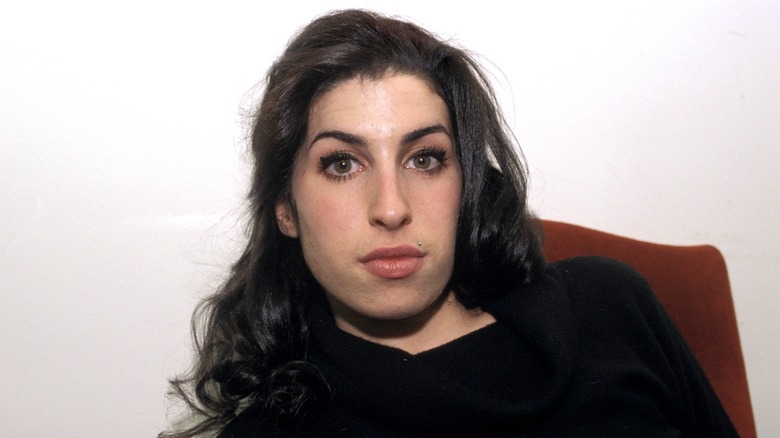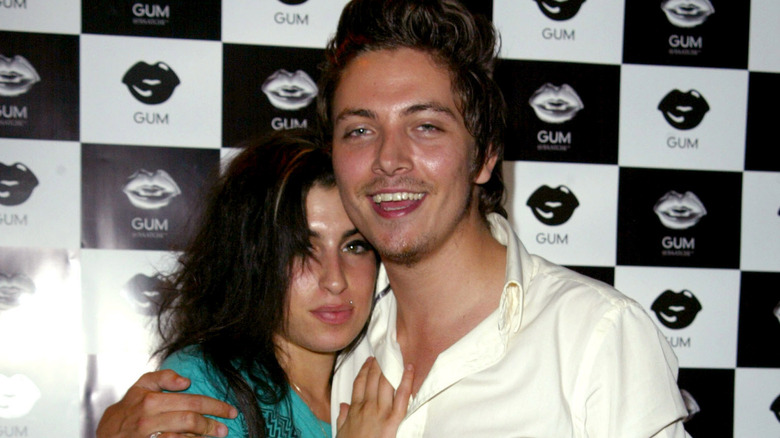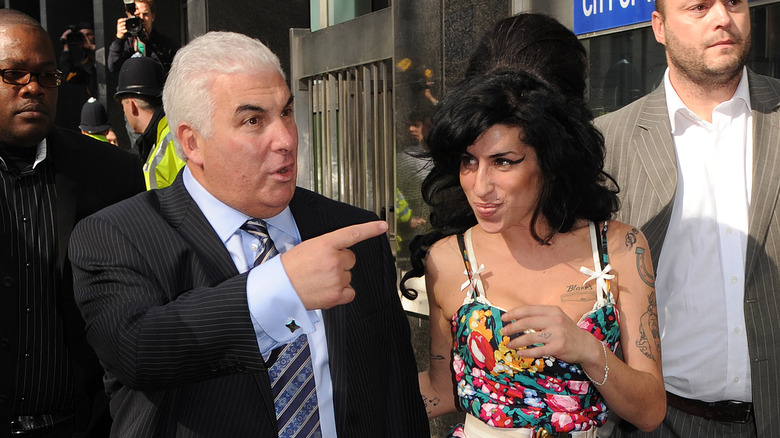Things Back To Black Left Out About Amy Winehouse's True Story
Even before it was released in movie theaters, Sam Taylor-Johnson's "Back to Black," her big-budget biopic of British jazz singer Amy Winehouse, has ridden a wave of controversy. Winehouse's life ended tragically in 2011, when she was found dead in her London home, aged just 27. She had struggled with substance abuse issues, experienced a heartbreaking rollercoaster marriage in the glare of the world media, and had every detail of her troubled life documented by the tabloid press, whose paparazzi photographers hounded her daily at the height of her fame.
Winehouse's tragic downfall is undoubtedly a story worth remembering, a cautionary tale that also shines the spotlight on how the modern world exploits the private lives of famous individuals for entertainment and ultimately fails them. It is no wonder, then, that many fans were uncomfortable with a Hollywood retelling of a sad life that played out in living memory, and which surely requires both subtly and nuance in its retelling.
Indeed, "Back to Black" has been released to mixed reviews from critics and moviegoers. The movie has been praised by some for its casting, particularly that of Marisa Abela (pictured), whose capturing of Winehouse's mannerisms is often uncanny (though some have taken exception to their lack of physical resemblance). But Taylor-Johnson's film has also been criticized for the way it simplifies and sanitizes Winehouse's story, even as it portents to address her addiction issues. Here are some details of the singer's life that the movie left out.
The following article includes allegations and descriptions of addiction.
Amy Winehouse's early life
"Back to Black" opens with Amy Winehouse in her late teens, at the home of her grandmother, where her family has gathered for dinner, wine, cake, and a sing-along. It is clear from the scene that Winehouse's circle of family and friends is large, but what isn't mentioned is that she had an older brother, Alex, who was four years her senior and taught her to play guitar. Winehouse's mother and father are both at the gathering, and it is revealed that her parents are divorced and living separately.
"Back to Black" suggests that Winehouse is still upset about the divorce, but in reality, it was finalized when she was 9 years old, suggesting that she would have been used to the arrangement by the time her career began. The movie also glosses over the fact her father, Mitch, later remarried a woman whom he claimed in his memoir "Amy, My Daughter" he had been in love with for many years during his marriage. Mitch also claims that Winehouse accepted the separation easily.
The opening scene also sees Winehouse talking to her beloved grandmother, Cynthia. During their conversation, Winehouse refers to her being expelled from school. According to legend, this happened at Sylvia Young Theatre School, and was a consequence of her wearing a nose ring. However, the school itself rejects the notion that she was forced out, and insists instead that she simply switched schools when she received an opportunity she couldn't turn down.
Prestigious training
"Back to Black" portrays Amy Winehouse's true-to-life relationship with her grandmother, Cynthia, to whom she was devoted and whom she describes in the film as her "style icon." Cynthia was a notable singer on the London jazz scene and was in a relationship with Ronnie Scott. Scott was the operator of a famous jazz club bearing his name, at which some of the greatest British and American talent played over the decades.
What is missing from the film is that as well as being Winehouse's role model, Cynthia was instrumental in turning her granddaughter away from traditional schooling and toward performance. After she attended the Sylvia Young Theatre School, Winehouse won entry to the prestigious BRIT school, which today is known for producing some of the UK's greatest stage and screen talent. Multi-platinum-selling singer Adele also attended the school, along with X Factor winner Leona Lewis and the "Spiderman" actor Tom Holland. Despite reportedly being disruptive at various schools she attended and disliking lessons in general, Winehouse was effusive about the BRIT school, and recalled her time there with fondness in later interviews, noting that, being free, it gives talented young people a chance to enter the entertainment industry which they wouldn't otherwise have.
An airbrushed best friend
In an early scene in "Back to Black," Amy Winehouse is asleep in bed when her phone rings. Annoyed, she answers with a barrage of curse words, which is awkward because at the other end is her friend, Tyler, who is on loudspeaker alongside his music manager. Tyler informs Winehouse that he has played his manager Winehouse's demo, and he loves it. The scene represents Winehouse's big break, and Tyler has been instrumental in making it happen.
Tyler is Tyler James, a musician of some note in his own right. But what "Back to Black" fails to show is quite how close the two were. James and Winehouse met at school at the age of 12 and became best friends over their shared love of music. Their relationship lasted into adulthood and long after Winehouse became a household name: James lived with Winehouse from the age of 18 right up to her death at the age of 27, a detail missing from the film.
Tellingly, in the wake of its release, James has been highly critical of the biopic, telling the tabloid The Sun on Sunday that it is a "dreadful" rendering of his late friend's life. "They sugar coated, glossed over her amazing life and missed out huge chunks. It is not telling her story. So much more could have been told in this film that would have built up a better and fuller picture of who Amy was," he added, claiming that Winehouse would be "furious" over her portrayal.
The truth of Blake Fielder-Civil
"Back to Black" has been knocked by some critics and Amy Winehouse fans for its somewhat sympathetic portrayal of Blake Fielder-Civil, the video production assistant she married in 2007 after a whirlwind romance, and who was sentenced to prison just months later. Though the biopic depicts Fielder-Civil offering Winehouse cocaine the morning after their first night together — which she declines — Winehouse is later shown ordering rocks of crack herself and smoking it alone.
The truth is that Fielder-Civil has taken full responsibility for introducing Winehouse to hard drugs, and there was far more to the story of his legal troubles than "Back in Black" let on. He was a controversial figure in his own right during his relationship with Winehouse: In June 2007, Fielder-Civil was involved in a widely reported fight with James King, the manager of London pub The Macbeth, which resulted in King needing significant surgery to repair a broken cheekbone. Fielder-Civil and a man named Michael Brown, who was also involved in the assault, then attempted to pervert the course of justice by bribing the victim with $400,000. Whether this money came from his wife is unclear, but considering Winehouse's net worth, it's not improbable.
Though "Back to Black" suggests Fielder-Civil overcame his addictions in jail and was a repentant figure, he was jailed once more on burglary and firearm charges. And although they divorced after two years of marriage, rather than a clean break, the pair later got back together for a time and mulled over the idea of remarriage.
Celebrity friends
Considering Amy Winehouse was one of the biggest names in British pop during her short career, "Back to Black" is curiously free of other famous faces. Apart from her interview with British chat show host Jonathan Ross and her friendship with Tyler James, it appears from the biopic that she was barely in contact with other celebrities at all. The truth is that Winehouse had several famous friends with whom she would often party in Camden, such as Kelly Osbourne and the comedian Russell Brand, who knew Winehouse long before she was a household name. Brand wrote warmly of their friendship after her death, describing her as a "beautiful, talented woman" and regretting that as someone recovering from addiction, he had been unable to intervene in hers.
Another London figure Winehouse knew well was the oft-troubled Pete Doherty, the lead singer of indie rock band The Libertines, and who has also faced addiction issues in the public eye. The pair notoriously appeared in a bizarre YouTube video in late 2008, in which they both appeared high and in possession of a box of baby mice. The video, titled "Winemouse," sees the pair address Blake Fielder-Civil, asking him not to divorce the "Rehab" singer. Years after Winehouse's death, Doherty, who was pictured frequently on nights out with the singer, admitted that he and Winehouse had an affair.
On a more wholesome note, Winehouse's meeting with her hero Tony Bennett, with whom she duetted in 2011 shortly before her death, was also absent from the film. They recorded a well-received duet in 2011, shortly before her death.
Hospitalizations
In 'Back to Black," the people in Amy Winehouse's life admonish her for not taking epileptic fits seriously; instead of going to the hospital for treatment, she brushes such worrying incidents off. Indeed, the only treatment she receives throughout the film comes when she finally decides that she needs to go to rehab. In reality, there were several occasions when the Ivor Novello award winner had to be hospitalized. In 2007, the singer, who had already conquered the U.K., had a lucrative tour of the U.S. canceled after she was hospitalized due to an overdose of hard drugs. Later that year, she and her husband, Blake Fielder-Civil, went to rehab together to try to combat the addiction that was by then being writ large in the newspapers, but left within days of checking in.
News of further hospitalizations came in 2008, when she had a seizure after an argument with her recently paroled husband. A source close to the singer claimed that the medical intervention was one of many such instances over the years.
Escape to St. Lucia
During the peak years of her fame, Amy Winehouse found that her every move was followed by the press, and that in public, she was constantly pursued by paparazzi looking to get the latest front-page snap of the troubled star. This aspect of her life is covered in "Back to Black," which features numerous scenes of Winehouse encountering walls of photographers with flashlights, who manage to capture her at her lowest moments.
Thankfully for Winehouse, she devised an escape from the media circus, one that wasn't featured in the film at all. In 2009, when she was under growing pressure from her record label to write a follow-up record to the Grammy Award-winning "Back to Black," she retreated to a luxury resort on the island of St. Lucia. Originally intended as a vacation following a successful round of rehab to combat her drug addiction, she remained on the island for eight months. There, she enjoyed the beaches, took up horse riding, and reportedly made the acquaintance of the island's stray dogs.
It was around this time that Winehouse set up her own label, Lioness, through which she helped launch the career of her goddaughter and protege, Dionne Bromfield. However, she struggled to record more songs of her own, with reports claiming that despite having kicked heroin and crack, she was drinking heavily on the island, and wasn't confident that she could replicate the success of her hit sophomore album.
Mitch Winehouse controversies
"Back to Black" paints Amy Winehouse's father Mitch as a loving if somewhat controlling figure in her life, who went out of his way to guide his young daughter in the early stages of her career, and had no qualms telling her what she didn't want to hear. But Mitch is a far more controversial figure than the movie suggests.
Around the time that Winehouse was sheltering from the press in St. Lucia, the relationship between father and daughter began to grow strained. Mitch was fond of giving interviews to any news outlet that would have him. But even as Winehouse's health deteriorated and her addictions grew, Mitch's thirst for publicity didn't cease. In one notorious incident, Mitch turned up at the island with a camera crew to make a documentary about his daughter, seemingly against her wishes, and she tried her best to hide from the camera whenever possible.
The sense that Mitch was intruding on his daughter's recovery was heightened by a post on then-Twitter (now known as X) when the documentary aired, which read: "WHY don't my dad WRITE a SONG when something bothers him instead of going on national TV? ... you thought YOUR parents were embarrassing" (via Luxury London). Mitch's reputation among fans fell further with the publication of his seemingly cash-in memoir, "My Daughter Amy," released just a year after Winehouse's death. Meanwhile, the 2015 documentary "Amy," to which Mitch contributed interviews, contained such a negative account of Mitch's relationship with his daughter that he attempted to take legal action against the filmmakers.
Later relationships
It is clear from "Back to Black" that her marriage to Blake Fielder-Civil was the most seismic romantic relationship in Amy Winehouse's life. The singer had a tattoo of her husband's name inked at the same time as pieces commemorating her relationships with her father and grandmother. But where "Back to Black" documents Winehouse's despair at her break-up with Fielder-Civil, it erroneously suggests that their marriage was the last love affair she had before her tragic death.
The truth is that Winehouse had multiple relationships after her 2009 divorce, two of which were widely reported in the tabloids. The first was with Mik Whitnall, the guitarist of the famously dissolute Pete Doherty-fronted indie band Babyshambles. It was reported that Whitnall, also known to misuse drugs, had taught Winehouse to take cocaine by mixing it with cotton candy.
Winehouse also had a serious relationship with a man named Reg Traviss. The pair were together for the last two years of the singer's life and were engaged to be married, which undermines a major suggestion in "Back to Black"; that Winehouse's discovery that Fielder-Civil had a baby with another woman led directly to her death by alcohol poisoning.
A tragic last performance
Several of Amy Winehouse's most iconic live performances are reproduced in "Back to Black," often with uncanny detail and accuracy. However, the biopic fails to mention that throughout Winehouse's career, her addictions began to impact her abilities to the point where her shows left her fans dissatisfied and frustrated. On occasion, she was unable to perform at all.
Even on St. Lucia, reports emerged of a shambolic festival performance in which she cursed at the audience and left the stage after four songs. But worse was to come, as her health began to decline once again after her return to London and the supposed resumption of her career. As Winehouse entered rehab and attempted to maintain sobriety, her tour team was instructed to remove any alcohol from her hotel rooms. Sure, those measures resulted in some acclaimed performances, including at London's prestigious 100 Club. But in June 2011, footage emerged of an obviously inebriated Winehouse on stage in Serbia, slurring her words and unable to perform, all to boss and jeers from the crowd. The media, particularly the tabloids and music press, were damning. Little did they know that it would be Winehouse's last stage appearance before her tragic death, which occurred only a month later.
The dangers of relapse
At the end of "Back to Black," Amy Winehouse ascends the stairs of her London home toward what we know to be her tragic death at the age of 27, news of which would send shockwaves around the world. An epilogue displayed on a black screen tells the viewer that Winehouse died of alcohol poisoning, as her autopsy report confirmed.
The film makes it clear that Winehouse had been sober for an extended period before the excessive drinking episode that killed her. According to her stepmother, Jane, who spoke to The Independent on the tenth anniversary of Winehouse's death, the singer had been going through longer and longer periods of sobriety before relapsing. "We thought she was going to pull through. We thought she was going to beat it," Jane said.
Such a development may sound like progress, but the truth is that as periods of sobriety lengthen, a person's tolerance for alcohol becomes gradually lower. This makes a relapse especially dangerous, especially if the person resumes their intake at the levels they were used to at the height of their addiction. In the wake of Winehouse's death, health practitioners urged greater awareness of the "tolerance effect," which could save the lives of other people with addiction issues in the future.
If you or anyone you know needs help with addiction issues, help is available. Visit the Substance Abuse and Mental Health Services Administration website or contact SAMHSA's National Helpline at 1-800-662-HELP (4357).











